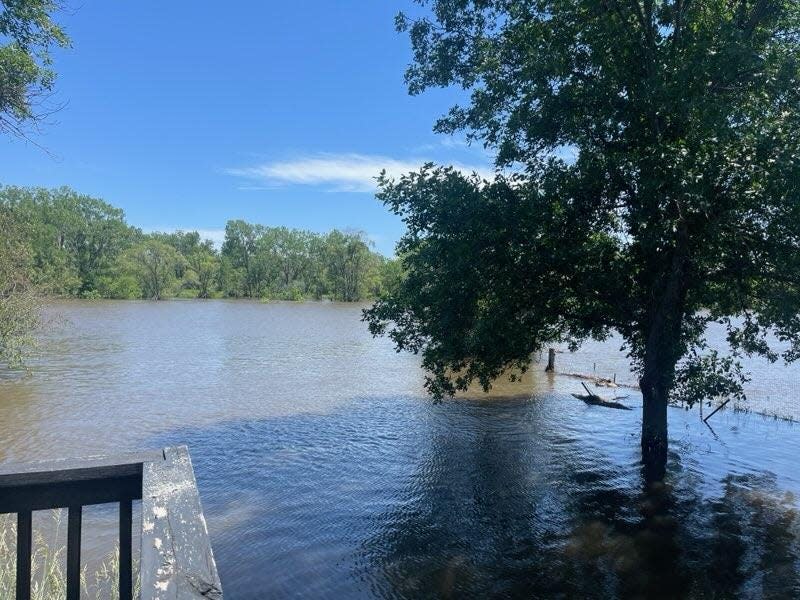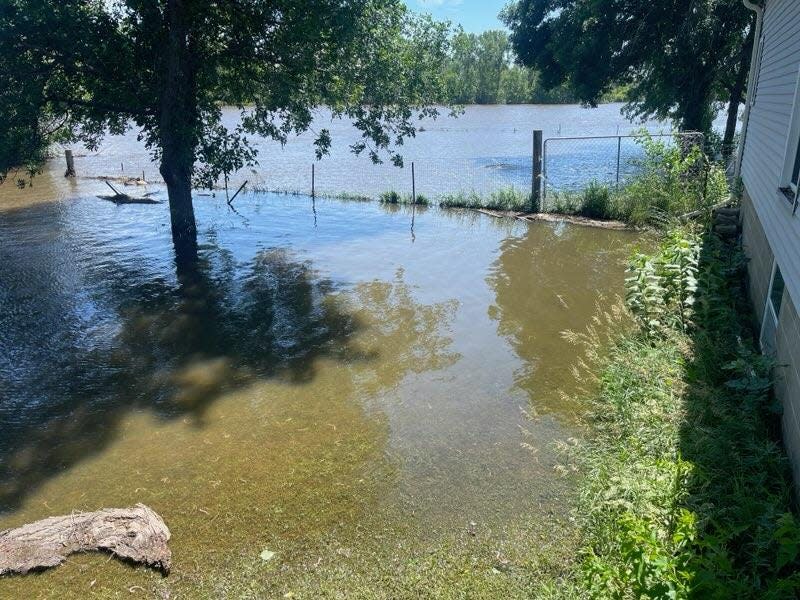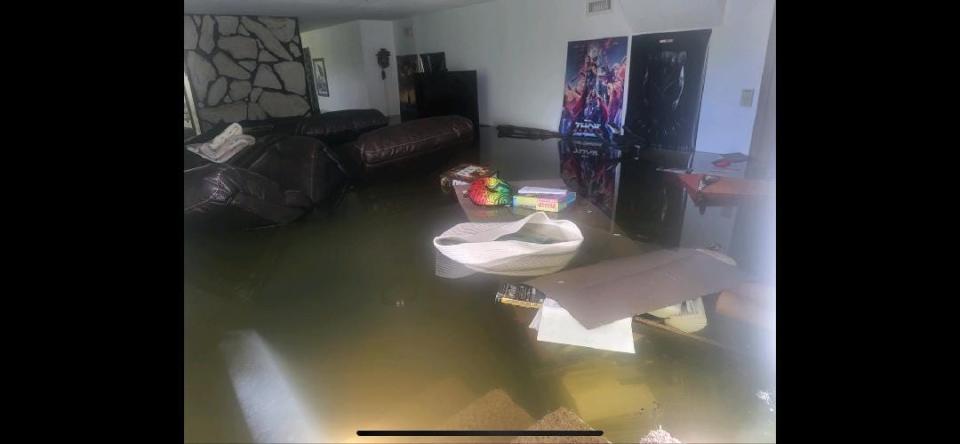One couple's dilemma: Floods devastate house, force evacuation, but no emergency funds yet
- Oops!Something went wrong.Please try again later.
Clay County couple Chelsey Green and Ross Loebs were forced to evacuate their home near Vermillion early the morning of June 23 because of rising flood levels from the Vermillion River.
Their home of four years took on 4.5 feet of water in their finished basement, where Green said they spent about 80% of their time as their main living space.
The couple bought their three-bed, one-bath home on 5 acres of property in September 2020. They were told the previous owner had moved the house to this spacious piece of land in the country near the Vermillion River and lived in the home since the ‘70s.
“She was very proud that the sump pump had never run and they never had water in their basement,” Green said of the previous owner.
Now, like many affected by the mid-June flooding in southeastern South Dakota, Green and Loebs are stuck in limbo, waiting for possible financial aid to come through so they can begin rebuilding their lives, especially because insurance won't cover the damage.
“I’m still hoping there’s help coming,” Green said. “Until there is, stabilizing the situation is all we can do. We will not be able to rebuild within the next year unless funding is found.”
The calm before the storm
Green, a teacher at UmonHon Nation Public School and Loebs, a maintenance employee at USD and drummer for Sioux Falls cover band, Totally Rad moved into their home feeling assured they wouldn’t have any flood-related issues.
The new homeowners started making the space their own gradually.
As homeowners in their 20s and 30s, the couple "put all their chips into owning their first home." With a limited budget, they were able to make several updates and improvements via DIY and YouTube tutorials.
“This house was our sanctuary,” Green continued. “Anyone who walked in could tell exactly who we were. We really put our soul into building a home.”
On June 22, the Vermillion River started to swell and flood alongside the gravel road leading to the property. Later that evening, after the sun had long set, the water had reached the front of their house.
Green said they knew it was going to flood, but “felt a real sense of security" knowing the previous owners lived in the home for 50 years, during record-high river crests, and never had water in the house.

A playset sitting in their yard served as their indicator as to whether the water would reach their house. Green said they were told by the previous owner that water never went past it.
Still, the couple took precautions. The septic tank was closed off from inside the house to prevent sewage backup, and the sump pump was double-checked for functionality.
More: 'Not much sleep:' Residents share stories of flooding impact
“We packed emergency bags and did general house maintenance,” Green said. “We felt safe.”

By 1:30 a.m. June 23, the water had traveled well past the playset safety net and nowhere near the predicted river crest.
As Governor Kristi Noem stated on July 2 via X, formerly Twitter, the overwhelming amount of "powerful and unprecedented" water eventually created a larger riverbed for the Vermillion River and "eroded away" between 5 and 10 acres of residence and farmland in the path.
The flood waters were so powerful and unprecedented that they carved a broader riverbed for the Vermillion River. They eroded away 5-10 acres of farmland and threatened homes, but these residents acted quickly to shore up the riverbank themselves.
Thanks to Vermillion Mayor Jon… pic.twitter.com/XuWOIyPSgU— Kristi Noem (@KristiNoem) July 2, 2024
“We knew we were in trouble,” Green said.
The couple quickly began packing up cars and moved what they could to the main level or onto desks or shelves. The farm animals were relocated to the safest spots they could get them and their two large dogs, Asha and Juneau, were loaded up.
By 3:45 a.m., the driveway, their only way out, was beginning to flood.
“We decided if we were going to evacuate, it had to be then,” Green said.
Green and Loebs drove two hours to stay with family. They had faith that their sump pump could handle everything, but by noon that next day, their optimism had been washed away.
The couple was able to keep an eye on things with cameras set up, but it was soon evident water was beginning to fill the basement. Eventually, the power was shut off for safety purposes and they lost visual of what was happening to their house.
The homeowners watched in dismay as their primary living space filled with nearly 2 feet of flood water.
“We were filled with anxiety, should haves and what ifs but we could do nothing but wait,” she said.
The aftermath
The next day, on June 24, they drove back home to assess the damage. After parking on the road and wading through thigh-high-level water to the house, Green and Loebs discovered their basement submerged in nearly 4.5 feet of river water.

“Everything we had put up high was floating on the surface. Useless," Green said. "Our water heater, furnace, fireplace, electric wiring, stairs, freezer, TV, couch, bookcase deck, etc. were all underwater."
The water table was still too high to start pumping out water, so a few more things were packed, the chickens were moved next door and they drove away from their home surrounded by water again.
On June 26, they made the journey home a second time. Thankfully, the water had receded enough to start pumping out.
More: McCook Lake residents say their homes were sacrificed, and they want a new flood plan
“It’s still hard to see the extent of the damage, but it is apparent that our deck is leaning toward the river flow, and everything in the basement is completely submerged,” Green said.
As much as Green and Loebs wanted to dry things out as soon as possible, they could only pump out 1 foot every 24 hours to prevent damage to the foundation.
The last inch of water was emptied at 9 p.m. June 28.
By July 1, everything in the basement was gutted to the studs and bleached with help from friends and family.
Josh Loebs, Ross Loebs' twin brother, said many people helped out in some way, whether it was supplying fans and dehumidifiers to carrying out drywall and furniture.
"It has been tough watching my brother and Chelsey go through this, but it was also great seeing how many friends, neighbors and family members rallied around them to help," Josh Loebs said.
Another pain point - quite literally - had occurred at the end of the day, however. Green ended up in the emergency room with a nail in her foot, but nothing a tetanus shot and some antibiotics won’t fix.
Then arose the next roadblock: how to physically and more worrisome, financially, get everything back to normal.
Insurance didn’t cover any of the damage.
“We are told that if a tree hit our window and the water came in, we would be covered. No trees broke the window, thus we are at the mercy of disaster relief,” Green said.
Keeping their heads above water
Instead, they filled out a damage assessment and sent it to the Clay County Emergency Manager Layne Stewart, who is collecting damage reports in the area.
All they can do now is wait and hope.
As of June 29, Green said they “estimate anywhere between 35-50k in damages and losses but are really just starting to tear into it. So far, FEMA is not accessible for our area but we are checking multiple times a day hoping they will come through.”
More: Beware of scam artists, South Dakota attorney general warns flooding victims
By July 2, Green said they were told by city officials they were not eligible to apply for FEMA and wouldn’t have access to many programs until it’s declared a National Disaster by the White House.
According to FEMA.gov, one of the requirements for declaring a disaster is the governor has to submit a request to the president within 30 days of the occurrence of the incident.
Gov. Noem began this process on June 22 by signing an executive order to issue an emergency declaration.
Damage estimates must hit FEMA's threshold of $1.6 million for the state to be eligible for the emergency funds, which Noem said would occur "for sure."
To reach that threshold, South Dakotans affected by the flooding were asked to submit damage reports by July 12 to the state Department of Public Safety’s Office of Emergency Management, according to previous Argus Leader reporting.
More: Residents, businesses asked to report flood property damage as state seeks disaster relief
According to a July 1 press release from the South Dakota Department of Public Safety, the state assessment will cover up to 30 counties and is scheduled to take place beginning the week of July 15.
Ian Fury, Chief of Communications for Noem, said this week South Dakota has "far surpassed" the $1.6 million threshold. After FEMA assesses the damages, he said they "will take the next steps on the disaster declaration at that time."
So far, both Minnesota and Iowa have had major disasters declared by the White House.
“It’s very overwhelming and we are terrified we won’t be able to fund the restoration, but we have no choice but to keep moving forward,” Green said. “We are thankful we are safe and didn’t lose any of our pets. Our heart goes out to those who weren’t as lucky.”
This article originally appeared on Sioux Falls Argus Leader: Vermillion couple evacuates after 4+ feet of water floods basement

